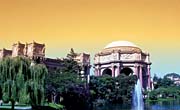
The site goes on to explain that the Palace's original columns and rotunda were framed in wood and covered with "staff," a mixture of plaster and burlap-type fiber. A move to preserve the Palace began the same year as the Exposition. Supporters raised $350,000 towards the goal of redoing the building in lasting materials. The San Francisco Art Association, which first maintained the Palace, attempted to raise additional funds. After World War I, the Palace became part of the city park system. Federal funds were used to repair and replace some of its decorations. During the Second World War, the U.S. Army used the Palace as a motor pool.
Unfortunately, the Palace slowly crumbled and eventually had to be fenced off because it was a public hazard. In the late 1950s, a group of citizens led by philanthropist Walter S. Johnson began an effort to save the Palace from planned demolition and restore it to its original luster.
On July 20, 1964, reconstruction of the Palace of Fine Arts began. Workers removed original design elements from which molds were made. The rotunda, colonnade and all except the steel framework of the gallery were torn down and replaced with concrete castings. Warner Hobart, of Hobart Bros., which represents Gaco Western products in the San Francisco area, says that the structure was then waterproofed using the Gacoflex 20NH system. At this time, "Neoprene-hypalon was chosen because it was a state-of-the-art elastomer," says Hobart.
Adrian Jenkins, senior vice president of Gaco Western, has been with the company for 40 years. He notes that Gaco has a lot of history with the Palace of Fine Arts and says that in the 1980s, the dome was recoated again for appearance. Adds Hobart, "In the ‘80s the original coating was still in place, and because very old neoprene and hypalon are solvent sensitive, we used Gacoflex A-5400 acrylic latex coating."
Now entering a new century, the Palace of Fine Arts needs another facelift. This time around it is not a simple "recoat" but a total strip down and new application. "The existing coating dated back to the 1960s and it would be very risky to rely on the bond of the old material," explains Hobart. In addition, "This was a substantial change in both chemistry and physical performance. The old system exhibited physical properties in the range of 700-psi strength, and 200-300 percent elongation in a heavily solvented (25 percent volume solids) coating. The newer system is 2,100-psi strength and 400 percent elongation in a partially solvented coating (75 percent volume solids)."
Hobart says that this time around his company is working with a roofing consultant and an architect familiar with landmark properties. They all agreed that the existing coating would be removed and replaced with a new 45-UB/UA system. The system consisted of a sealer, primer, basecoats and UA-60 topcoat (aliphatic gloss urethane) in a special color.
"The difficulty in applying coating to a dome surface 170 feet in the air is pretty unique," continues Hobart. "The removal of the existing surface involved hand-operated scabblers and scarifiers to remove the 40-year-old buildup of elastomeric coatings." In addition, "The dome itself is made up of individual pie-shape pieces bolted onto a steel frame. Where each of these sections meets, Gacoflex neoprene sheet at a width of 9 inches was installed. This permits each section to move without affecting the overall performance of the membrane."
Someone who knows full well what challenges this job entailed is Michael Smith, superintendent and project manager for Best Roofing and Waterproofing. The company has been in business for over 15 years and has offices in San Francisco, Hayward and Gardena. After coming in as the low bidder, a crew of 15 began work on the Palace of Fine Arts in June of 2004. A successful company that does a lot of high profile jobs, Best Roofing is experienced with Gaco products.
The scope of the job involved much more than the recoating. First, workers removed existing lights. The next step was to prep the deck and dome by removing the coating, scarifying and grinding. Crews then repaired cracks, did some patching and removed and replaced the drain bowls, followed by sealing with Sika 223 and Armortech 110. Crews also changed rain leaders (from galvanized to copper) at this time, followed by more patching and caulking. Next came primer (Gaco Western's E-5320, a water-based material that is an adhesion promoter for concrete and metal.), base coat and top coats from Gaco. The last step was to replace the lights, which crews were still working on as of December 2004.
Best Roofing also had to install manlifts and ladders to access the job site. Workers had body harnesses, lanyards and rope grabs for safety. Smith agrees that the most challenging aspect of the job was scarifying the dome: "Down toward the edges it was almost vertical and we used hand-held tools."
Having a first-rate contractor work on the Palace of Fine Arts ensured a successful outcome, but how has Gaco Western managed to get its products repeatedly chosen to protect one of San Francisco's finest landmarks? "In the ‘60s, Gaco was the leading supplier of high-performance, liquid-applied elastomeric coatings, a relatively new concept," says Hobart. Hobart Bros. had well-established roots and contacts in the architectural community at that time and the same family has run the business since then. In the ‘80s, Hobart Bros. was in close contact with the city and had contractors in place, capable of performing this challenging project.
It's the same story for the current job, where Hobart is working with the roofing consultant, historical architect, and the city to develop a suitable assembly to meet all the requirements. "Color was a big issue, as was approved applicator capability-both monetary and labor related-and warranty," says Hobart. Most importantly, "Since its original coating, Gaco Western's products have performed well, and the company has always maintained a good relationship with the city and county of San Francisco."
Report Abusive Comment